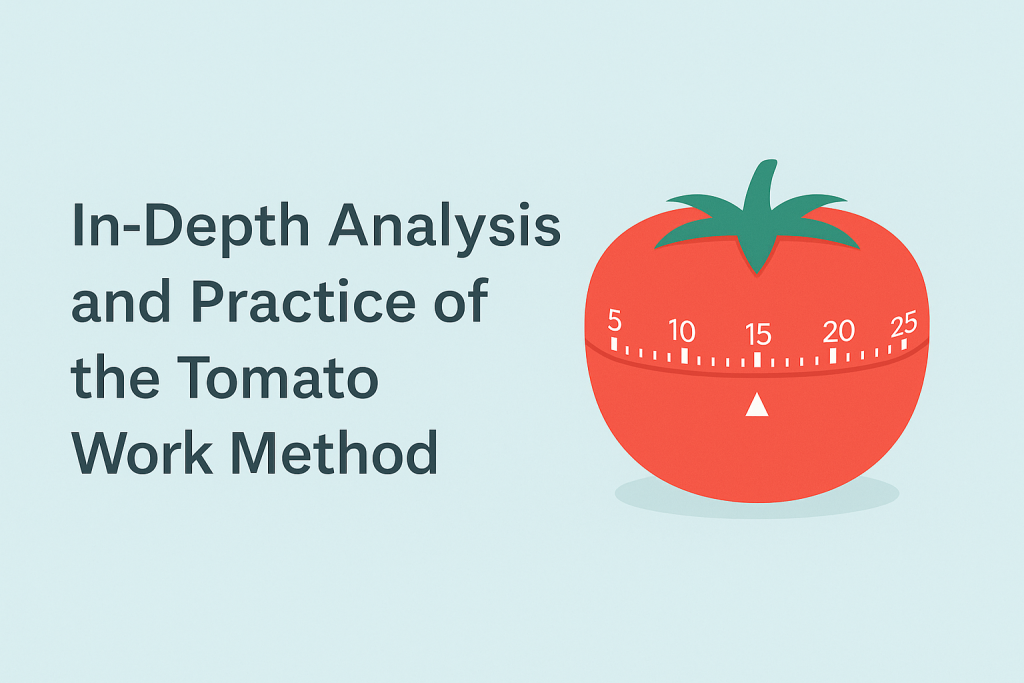In-depth Analysis and Practice of the Tomato Work Method
Boost productivity and beat procrastination—25 minutes at a time
Always Busy but Rarely Productive?
You sit down to work and hours pass—but you still feel like you haven’t done enough. Maybe your to-do list keeps growing, or distractions pull you away before you make real progress. If that sounds familiar, you’re not alone.
In a world of constant interruptions and information overload, staying focused is a skill. Fortunately, there’s a proven time management method that can help you reclaim your attention and structure your day with purpose: the Tomato Work Method, more widely known as the Pomodoro Technique.
In this article, we’ll provide an in-depth analysis and practice of the tomato work method, from its origins to its real-world application—and how you can use it to work smarter, not just harder.
—
What Is the Tomato Work Method?
The Origins
The method was developed by Francesco Cirillo in the late 1980s. He used a kitchen timer shaped like a tomato (“pomodoro” in Italian) to track focused work intervals. The technique has since become a global productivity staple.
How It Works
The core idea is simple: Work in short, focused bursts (called Pomodoros), followed by short breaks. This helps maintain concentration, prevent mental fatigue, and create a sense of rhythm in your day.
The Classic Pomodoro Cycle
- ⏱️ 25 minutes of focused work (1 Pomodoro)
- ☕ 5-minute break
- 🔁 After 4 Pomodoros, take a longer break (15–30 minutes)
These intervals train your brain to stay focused for short periods while giving it time to rest and recover between sessions.
—
Why the Tomato Method Works
1. Builds Focused Work Habits
Knowing you only need to concentrate for 25 minutes reduces resistance to starting. Over time, these sprints condition your brain to stay on task and reduce procrastination triggers.
2. Prevents Burnout
Scheduled breaks help prevent cognitive fatigue. Unlike marathon work sessions that drain you, Pomodoros promote sustainable energy throughout the day.
3. Improves Time Awareness
Most of us underestimate how long tasks actually take. Tracking Pomodoros brings clarity to your workflow and helps with more realistic planning.
4. Reduces Multitasking
Each Pomodoro is dedicated to one task only. This trains your mind to single-task—enhancing depth, efficiency, and quality.
—
How to Apply the Tomato Work Method in Practice
Step 1: Choose a Task
Select a specific task or project you want to focus on. Be clear and intentional—vague tasks like “work on presentation” can lead to scattered effort.
Step 2: Set a Timer for 25 Minutes
You can use a classic kitchen timer, your phone, or productivity apps like Focus To-Do, Forest, or Pomofocus. Avoid checking the clock—let the timer manage your time.
Step 3: Work Without Distraction
Commit fully during this window. Turn off notifications, close irrelevant tabs, and let others know you’re in a “deep work” sprint.
Step 4: Take a Short Break (5 Minutes)
Stretch, hydrate, walk around—step away from your screen. This pause allows your brain to reset and boosts long-term retention.
Step 5: Repeat and Track
After 4 Pomodoros, take a longer break. Reflect on your progress and adjust your task priorities. Keeping a log of Pomodoros helps build accountability and motivation.
—
Tips to Customize Your Pomodoro Practice
Adjust Intervals as Needed
Some people find 50/10-minute sessions more effective. The key is maintaining a balance between deep work and recovery.
Use Pomodoros for Planning and Review
Pomodoros aren’t just for execution. Dedicate one session to planning your day or reviewing your week to improve future focus.
Protect Your Time
Use visible signs (like headphones or status lights) to signal you’re in a Pomodoro. This prevents unnecessary interruptions from colleagues or family.
—
Conclusion: Productivity Is About Rhythm, Not Rush
The tomato work method helps you approach your day with structure, intention, and mindfulness. By working with your brain’s natural rhythms—not against them—you reduce overwhelm, avoid burnout, and get more done in less time.
Don’t aim for constant productivity. Aim for focused cycles of progress—one Pomodoro at a time.
✨ Ready to try it? Set a timer for 25 minutes and begin. Subscribe for weekly productivity strategies, time-blocking templates, and deep work guides tailored to your goals.
